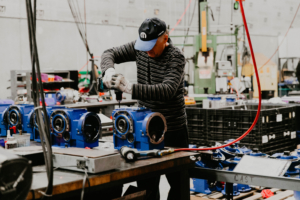The Top Five Trends Driving Modern Manufacturing
Manufacturing in Georgia
If you live or operate a business in Georgia, your life is, at the very least, indirectly affected by the manufacturing industry. Manufacturing accounts for 90 percent of Georgian exports. For the last five years, the manufacturing sector in Georgia has grown by 14 percent. The Georgia Manufacturing Alliance, which helps manufacturing leaders share ideas and make profitable business connections, continues to grow.
Simply put, manufacturing is a critical component to the health of our state’s economy. Because of this, it is critical for large Georgian businesses to understand the current landscape of modern manufacturing and the trends that are driving modern manufacturing into the future.
Trends
We have gathered the top five trends that are driving modern manufacturing today. Many of these trends are incorporated within “Industry 4.0,” which is a catchall term used to describe the fourth industrial revolution in manufacturing. While the trends are not in any type of order, paying attention to all of these trends is critical not only for the health of your own company, but for the health of our state.
-
Cheaper and Faster Production due to 3D Printing:
3D printing (also called additive manufacturing) is exceedingly popular in the past number of years and continues to grow. It is described as a technology that is going to “revolutionize mainstream manufacturing.” 3D printing fell into the category of a prototyping tool when it first caught ground. Recently, the technology is being used more and more for actual production. Many small companies in Georgia are taking advantage of the increasingly sophisticated features that 3D printing can offer when manufacturing products.
Ultimately, as 3D printing technology improves, it will be incorporated into more supply chains. That said, 3D printing technology can help Georgian businesses today—so long as they are creative, willing to take risks, and see ways in which they can incorporate today’s 3D printing technology into their business. Taking the time to do this analysis could save your company significant time and money throughout the manufacturing process.
-
The Rise of the Internet of Things (IoT):
When most people hear the term “Internet of Things,” they often first think of the consumer applications of this new technology. Whether it is the Amazon Echo, the Nest Learning Thermostat, or something else, IoT technology has made consumers’ lives easier. Besides the consumer applications, however, IoT technology has improved the modern manufacturing process.
By using machines or equipment that are connected to the internet, companies can analyze real-time data in their manufacturing process and make adjustments as necessary. Companies in Georgia can optimize their processes and manufacture their goods or products in a faster and cheaper way. Like 3D printing, IoT technology continues to improve. Things like improving sensors, digital twins, and swarm and artificial intelligence promise to make factories even smarter than they are today.
-
Better Robots:
When discussing new trends impacting modern manufacturing, we would be remiss if we did not include a discussion of automation—particularly robotics. The combination of robots and artificial intelligence allows for the completion of certain work that would be considered unsafe or impossible for the average human worker. But besides this type of work, robots and humans will further collaborate. For instance, in tough industrial settings, manufacturers inside and outside Georgia that have strict return on investment requirements adopt collaborative robots. And for those businesses that don’t use their own robots? So-called “robot-as-a-service” companies provide pay-as-you-go workers depending on the scope of a manufacturer’s project or operations. In 2019, robots will continue to become increasingly sophisticated as manufacturers continue integrating robotics into common tasks.
-
More Useful Applications of Augmented Reality and Virtual Reality:
Augmented reality and virtual reality may seem like futuristic technologies that have no application today. While it may not be as ubiquitous as some other new technologies, augmented reality and virtual reality can be used today to make the manufacturing process more efficient and safe. Some companies, for instance, are using head-mounted devices integrated with augmented reality to provide a virtual overlay over real-world devices or objects in a factory. These sort of devices can lead to reduced costs, increased speed, fewer errors, and improved safety in a factory or manufacturing plant. While augmented reality and virtual reality are still in the early innings of development, they promise to improve workers’ productivity and safety while increasing manufacturing companies’ bottom lines.
-
A New War for Talent:
The manufacturing industry has always been competitive, but it has become especially competitive in terms of talent. While this is for a variety of reasons, this is primarily due to the rise of the disruptive technologies (listed above) and a skills gap on both the factory floor and in the back office. With a strong economy, manufacturers need to develop new ways of recruiting the best talent, whether that is through unique compensation structures or non-traditional perks. This is especially true for technical talent that can help manufacturers incorporate and leverage technologies in their businesses. If you manufacture goods or products in Georgia, it will help to begin sourcing local STEM talent from Georgia universities—including Georgia Tech and the University of Georgia.
Follow the Trends
Georgia manufacturers are facing a number of challenges and opportunities in the marketplace. As we have mentioned, the manufacturing industry is competitive. In all likelihood, it will only become more competitive. This is an important reality not only for an employee or owner of a non-manufacturing business in Georgia, but for Georgia citizens themselves.
Because of this, it is all of our responsibility to understand the realities that Georgia manufacturers are facing. While the above trends are just several that are affecting the industry, it is clear that technology is going to play a large part in driving modern manufacturing. That said, by understanding these trends and how they will affect Georgia manufacturers, we can do our part to make sure that they are leveraging these trends to the best of their ability.
As you can tell, we are clearly interested in the manufacturing industry. Having said that, if you are interested in manufacturing in Georgia and how these trends will affect the future, we recommend that you check out the Manufacturing Society of Forsyth County. Organized by the Cumming-Forsyth County Chamber of Commerce and often working closely with the South Forsyth Rotary Club, the Manufacturing Society of Forsyth County is a group of manufacturing professionals who work to share with and support each other and improve manufacturing in Forsyth County. To learn more about the society, fill out this form or email Vice President of Economic Development, Robert Long.
Interested in the top 5 trends driving Marketing, Healthcare or Technology in 2019? We have those too. Just follow the links to get fresh insights into these impactful industries.

